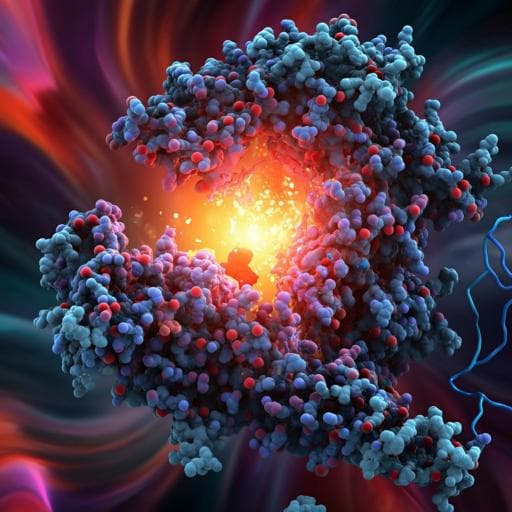
Biology
Structure and dynamics of an α-fucosidase reveal a mechanism for highly efficient IgG transfucosylation
E. H. Klontz, C. Li, et al.
Discover the fascinating world of fucosylation with the groundbreaking research from Erik H. Klontz and colleagues. Their study delves into the unique properties of AlfC, an α-fucosidase from *Lactobacillus casei*, revealing its mechanism through crystal structures and molecular dynamics. Uncover how this enzyme's specificity can impact protein functions and the potential for creating transfucosidase mutants.
~3 min • Beginner • English
Introduction
Fucosylation is a prevalent post-translational modification implicated in processes such as ABO blood grouping, antibody effector function, cancer progression, and immune cell biology. Alpha-fucosidases (GH29 and GH95) hydrolyze α-L-fucosyl linkages, with GH95 being inverting enzymes specific for α(1,2)-fucose and GH29 being retaining enzymes active on multiple linkages. GH29 enzymes are subdivided into A and B, with GH29A enzymes showing broad linkage specificity and GH29B specific for branched α(1,3/1,4) linkages. The molecular basis for substrate recognition and catalysis in GH29A remains poorly understood due to their diverse specificities and the difficulty in predicting the general acid/base residue by sequence. Conflicting chemical evidence has implicated different residues as the general acid/base across GH29A enzymes, whereas structural work in BT2970 identified a conserved mechanism. Lactobacillus casei AlfC is a GH29A α-fucosidase highly specific for α(1,6)-fucosyl linkages, central to human N-glycan core fucosylation. Prior work showed that mutation E274A converts AlfC into an efficient transfucosidase capable of direct core fucosylation of proteins using α-fucosyl fluoride. These observations raise key questions: what determines AlfC’s α(1,6) specificity, what residue acts as the general acid/base in AlfC, whether GH29A mechanisms are conserved, and why certain AlfC mutants act as efficient transfucosidases. The study addresses these questions with structural, kinetic, biophysical, and computational analyses.
Literature Review
Previous studies distinguished GH95 inverting α-fucosidases with α(1,2) specificity from GH29 retaining α-fucosidases that act on α(1,2), α(1,3), α(1,4), and α(1,6) linkages, with GH29 further classified into A and B subfamilies. The acid/base residue in GH29A enzymes has been controversial: azide rescue and mutagenesis implicated residues equivalent to E39 or E274 in some enzymes (e.g., Sulfolobus solfataricus Ssa-fuc, Nephilingis cruentata NcFuc, human FucA1, and Elizabethkingia cFase I), while structural and chemical data in multiple GH29 enzymes (e.g., BT2970 and others) support an acid/base located on a flexible loop analogous to D242 in AlfC. Prior glycoengineering approaches used endoglycosidases (EndoS/EndoS2) to trim IgG N-glycans to Fuc-α(1,6)-GlcNAc disaccharides before defucosylation by α-fucosidases, and demonstrated that AlfC E274A acts as an efficient transfucosidase to install core fucose on intact glycoproteins using α-fucosyl fluoride donors. Structural work in GH29 enzymes highlighted mobile active-site loops that adopt open/closed states and involvement of aromatic subsites in acceptor binding in transglycosylation by related enzymes.
Methodology
The authors combined multiple approaches: (1) X-ray crystallography of AlfCWT (2.5 Å) and variants, including ligand soaks with L-fucose, 4-nitrophenyl-α-L-fucopyranoside (4NP-fuc), and Fucα(1,6)GlcNAc; (2) gel filtration and analytical ultracentrifugation (sedimentation equilibrium and velocity) to define oligomeric state; (3) extensive site-directed mutagenesis of residues within ~15 Å of the active site (Asp/Glu/Asn and selected aromatic/charged residues), followed by colorimetric endpoint assays and detailed steady-state kinetics on 4NP-fuc to determine kcat and KM; (4) azide rescue experiments using both 4NP-fuc and α-fucosyl fluoride as donors, monitored by 19F NMR, and product stereochemistry confirmed by 1H/13C NMR; (5) hydrogen-deuterium exchange mass spectrometry (HDX-MS) to compare dynamics and solvent accessibility between WT and mutants (E274A, N243A), mapping differential deuteration onto structures; (6) molecular dynamics (MD) simulations (100 ns, CHARMM36m, explicit solvent, tetrameric assemblies) to quantify distances between the nucleophile D200 and candidate acid/base residues (E39, D242, E274) and identify open/intermediate/closed conformational states, including simulations of transfucosylation mutants (E274A, N243A, F237A, E274A/N243A) and a control hydrolytic mutant (N253A); (7) molecular docking (AutoDock Vina) of fucose, 4NP-fuc, Fucα(1,6)GlcNAc, and less-favored linkages (α(1,2)Gal, α(1,3)GlcNAc, α(1,4)GlcNAc) to rationalize specificity; (8) mass spectrometry analysis of IgG defucosylation with/without EndoS2; (9) chemoenzymatic fucosylation assays transferring fucose from α-fucosyl fluoride to GlcNAc and to a fully glycosylated IgG (S0G2 Herceptin), with MALDI-TOF-MS characterization and enzymatic confirmation of linkage by EndoS2 and AlfC treatment.
Key Findings
- AlfCWT structure: single-domain (β/α)8 fold GH29 enzyme lacking the common C-terminal carbohydrate-binding module; crystallizes and exists in solution as a tetramer with active sites ~37 Å apart.
- Active site and ligand binding: Fucose binds with interactions from H18, H87, Y131 (O4), E39/W40 (O3), W40/H88 (O2), and nucleophile D200 (O1); W283/W198 form a hydrophobic pocket for C6.
- Candidate acid/base residues: Structural analysis places E39 (~9 Å from D200 Oγ) and E274 (~12 Å from D200 Oγ, separated by W198) too distant and on rigid secondary structure to serve directly as acid/base. D242 lies on a highly mobile loop with high B-factors.
- MD simulations: AlfC samples closed conformations in ~11% of pairwise Oδ(D242)-Oδ(D200) distances (<7.5 Å), intermediates (~57%; 8–14 Å), and open states (~31%; >14 Å). In the closed state, R229 forms a salt bridge with D242, analogous to BT2970 (R262–E288), potentially recruiting D242 to the active site.
- Crystal structures with substrates: AlfCD200A+4NP-fuc remains in an open conformation (Cα–Cα D200A–D242 ~16.5 Å), contrasting with BT2970 closed state (~12.5 Å). BiAfcB shows open-to-closed movement from ~17.6 to ~12.1 Å Cα–Cα, supporting a conserved loop closure mechanism.
- Kinetics on 4NP-fuc: AlfCWT kcat 1.38 s−1, KM 0.70 mM (kcat/KM ~2 s−1 mM−1). E261A shows ~3× higher kcat; N243A shows ~103-fold lower kcat (3.21×10−3 s−1). D200A and R229A are inactive. E39A exhibits azide-dependent activity enhancement (10× increase in kcat with azide) but a large KM increase (to 14 mM), consistent with a binding role for E39. D242A and E274A have very low turnover.
- Azide rescue with α-fucosyl fluoride: Only E274A is rescued by azide to ~1/3 WT rate; the product is α-configured (J1,2 = 4.0 Hz), highlighting paradoxical rescue distant from the active site.
- IgG defucosylation: AlfCWT efficiently removes fucose from Rituximab only after EndoS2 trimming to Fuc-α(1,6)-GlcNAc; neither AlfCWT nor E274A defucosylates intact branched IgG even after 1 month.
- α(1,6)-specificity: The AlfCD200A–Fucα(1,6)GlcNAc structure reveals an aromatic +1 subsite (Y37, W40, W158) accommodating GlcNAc; the N-acetyl oxygen H-bonds to A154 backbone N. Geometry allows N-linkage to Asn297 but would clash at O4 with additional sugars, explaining lack of activity on intact branched glycans and the need for endoglycosidase pre-treatment. Docking of other linkages places the +1 sugar away from the aromatic pocket, near the D242 loop, likely clashing upon closure and reducing activity.
- Transfucosylation mutants: N243A shows high transfucosylation yields (~90% to GlcNAc; ~80–88% to intact IgG), comparable to E274A (~78–80%). E39A shows low yields (~2–5%); R229A, D242A, E244A show no transfucosylation. Rationally designed F237A (preceding the acid/base loop) confers transfucosylation (~17–20%). The double mutant E274A/N243A loses transfucosylation activity (~2%).
- HDX-MS: E274A shows increased deuteration (greater dynamics/solvent exposure) around R229 and the D242 loop; N243A shows subtler but increased deuteration in the D242 loop region; E274-containing β-strand remains protected in all constructs.
- MD of transfucosylation mutants: E274A, N243A, and F237A predominantly sample intermediate/open states with increased D200–D242 distances (mean +2–4 Å vs WT), consistent with a shift toward open conformations; changes in distances to E39/E274 are minimal.
Discussion
The findings support a conserved GH29 retaining mechanism for AlfC in which D200 is the nucleophile and a flexible loop-borne residue (D242) serves as the general acid/base in a catalytically competent closed conformation. Although closed states were not captured crystallographically, MD and structural homology strongly support loop closure and recruitment of D242 via a salt bridge with R229. The structural basis for AlfC’s α(1,6)-specificity is an aromatic +1 subsite that precisely accommodates GlcNAc in α(1,6)-linkages; this also rationalizes the requirement for endoglycosidase trimming and the lack of activity on intact branched IgG. The study reconciles why certain mutants (E274A, N243A, F237A) act as efficient transfucosidases: they shift the conformational ensemble toward open states that disfavor hydrolysis but can become catalytically competent upon acceptor binding in the +1 subsite, analogous to non-Leloir transglycosylases where sugar binding induces active-site organization for transfer while water cannot. The azide rescue experiments reveal limitations of using rescue to pinpoint acid/base residues in enzymes requiring substantial conformational changes; azide may stabilize active conformations by occupying cavities rather than directly substituting for the acid/base. Collectively, the data provide a mechanistic framework for rationally engineering transfucosidase activity by tuning loop dynamics, with implications for glycoengineering of antibodies and for identifying or designing enzymes capable of defucosylating or fucosylating specific glycan contexts.
Conclusion
This work elucidates the structural and dynamic determinants of substrate recognition and catalysis in the α(1,6)-specific GH29A α-fucosidase AlfC. Key contributions include: (1) identification of an aromatic +1 subsite driving α(1,6)-specificity; (2) evidence for a conserved catalytic mechanism involving a nucleophile D200 and a mobile-loop general acid/base (D242) recruited by R229; (3) demonstration that efficient transfucosidase activity can be achieved by shifting loop dynamics toward open states (E274A, N243A, F237A), enabling high-yield fucose transfer to GlcNAc and to fully glycosylated antibodies; and (4) clarification of why defucosylation of intact branched IgG is not observed without prior trimming. Future work should aim to capture closed, catalytically competent states experimentally (e.g., by cryo-EM or crystallography of stabilized complexes), resolve the azide-rescue paradox across GH29A enzymes, extend dynamic-tuning strategies to other α-fucosidases to create bespoke transfucosidases, and discover or engineer enzymes capable of defucosylating fully branched IgG or selectively editing glycan structures in complex biological contexts.
Limitations
Closed-state conformations with the acid/base engaged were not captured crystallographically; evidence for D242 as the acid/base is indirect (homology, MD, mutagenesis). Azide rescue results were substrate- and mutant-dependent and structurally implausible for E39/E274, highlighting limitations of rescue assays for enzymes requiring conformational changes. MD sampling was limited to 100 ns and conducted on apo enzymes, which may not fully capture substrate-induced dynamics; the double mutant E274A/N243A behavior indicates that apo simulations do not fully predict catalytic competence. AlfC and mutants cannot defucosylate intact branched IgG, constraining applications without prior glycan trimming.
Related Publications
Explore these studies to deepen your understanding of the subject.







